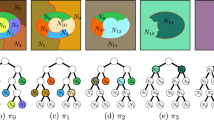Abstract
This paper defines the basis of a new hierarchical segmentation framework based on an energy minimization scheme. This new framework is based on two formal tools. First, a combinatorial pyramid encodes efficiently a hierarchy of partitions. Secondly, discrete geometric estimators measure precisely some important geometric parameters of the regions. These measures combined with photometrical and topological features of the partition allow to design energy terms based on discrete measures. Our segmentation framework exploits these energies to build a pyramid of image partitions with a minimization scheme. Some experiments illustrating our framework are shown and discussed.
Preview
Unable to display preview. Download preview PDF.
Similar content being viewed by others
References
Chan, T.F.: Active contours without edges. IEEE Transactions on image Processing 10(2), 266–277 (2001)
Leclerc, Y.G.: Constructing simple stable descriptions for image partitioning. International Journal of Computer Vision 3(1), 73–102 (1989)
Boykov, Y., Kolmogorov, V.: An experimental comparison of min-cut/max-flow algorithms for energy minimization in vision. IEEE Transactions on PAMI 26(19), 1124–1137 (2004)
Koepfler, G., Lopez, C., Morel, J.M.: A multiscale algorithm for image segmentation by variational method. SIAM J. Numerical Analysis 31(1), 282–299 (1994)
Morel, J.M., Solimini, S.: Variational methods in image segmentation. In: Progress in Nonlinear Differentiel Equations and Their Applications, vol. 14. Birkhäuser, Boston (1995)
Reddings, N.J., Crisp, D.J., Tang, D.H., Newsam, G.N.: An efficient algorithm for mumford-shah segmentation and its application to sar imagery. In: Proc. Conf. Digital Image Computing Techniques and applications (DICTA), pp. 35–41 (1999)
Guigues, L., Cocquerez, J., Le Men, H.: Scale-sets image analysis. International Journal of Computer Vision 68(1), 289–317 (2006)
Jolion, J.M.: Data driven decimation of graphs. In: Jolion, J.M., Kropatsch, W., Vento, M. (eds.) Proceedings of 3rd IAPR-TC15 Workshop on Graph based Representation in Pattern Recognition, Ischia-Italy, pp. 105–114 (2001)
Kropatsch, W.G., Haxhimusa, Y., Lienhardt, P.: Hierarchies relating topology and geometry. In: Christensen, H., Nagel, H.H. (eds.) Proceedings of Cognitive Vision Systems (Seminar Nº 03441 Dagstuhl) (2003)
Brun, L., Kropatsch, W.: Contains and inside relationships within combinatorial pyramids. Pattern Recognition 39(4), 515–526 (2006)
Lienhardt, P.: Topological models for boundary representations: a comparison with n-dimensional generalized maps. Computer-Aided Design 23(1), 59–82 (1991)
Klette, R., Rosenfeld, A.: Digital Geometry - Geometric Methods for Digital Picture Analysis. Morgan Kaufmann, San Francisco (2004)
Debled-Renesson, I., Réveillès, J.P.: A linear algorithm for segmentation of discrete curves. International Journal of Pattern Recognition and Artificial Intelligence 9, 635–662 (1995)
Feschet, F., Tougne, L.: Optimal time computation of the tangent of a discrete curve: Application to the curvature. In: Bertrand, G., Couprie, M., Perroton, L. (eds.) DGCI 1999. LNCS, vol. 1568, pp. 31–40. Springer, Heidelberg (1999)
Lachaud, J.-O., Vialard, A., de Vieilleville, F.: Analysis and comparative evaluation of discrete tangent estimators. In: Andrès, É., Damiand, G., Lienhardt, P. (eds.) DGCI 2005. LNCS, vol. 3429, pp. 240–251. Springer, Heidelberg (2005)
Coeurjolly, D., Klette, R.: A comparative evaluation of length estimators of digital curves. IEEE Trans. on Pattern Anal. and Machine Intell. 26(2), 252–257 (2004)
Author information
Authors and Affiliations
Editor information
Editors and Affiliations
Rights and permissions
Copyright information
© 2006 Springer-Verlag Berlin Heidelberg
About this paper
Cite this paper
de Calignon, M.B., Brun, L., Lachaud, JO. (2006). Combinatorial Pyramids and Discrete Geometry for Energy-Minimizing Segmentation. In: Bebis, G., et al. Advances in Visual Computing. ISVC 2006. Lecture Notes in Computer Science, vol 4292. Springer, Berlin, Heidelberg. https://doi.org/10.1007/11919629_32
Download citation
DOI: https://doi.org/10.1007/11919629_32
Publisher Name: Springer, Berlin, Heidelberg
Print ISBN: 978-3-540-48626-8
Online ISBN: 978-3-540-48627-5
eBook Packages: Computer ScienceComputer Science (R0)




